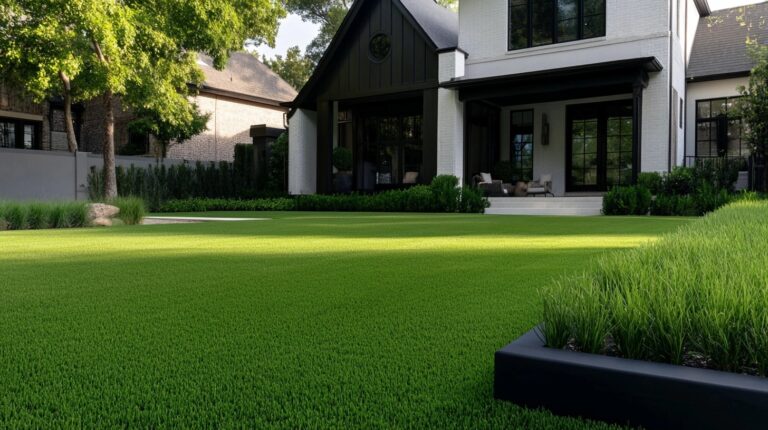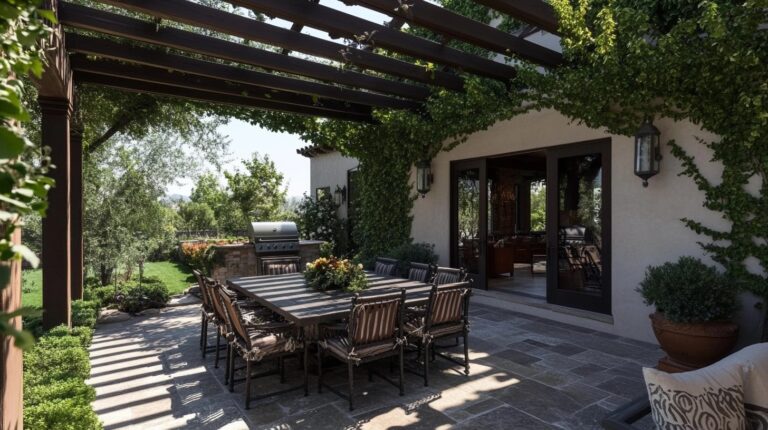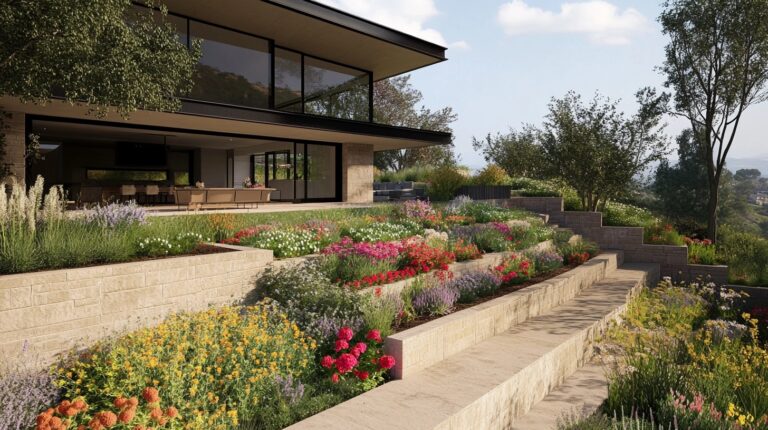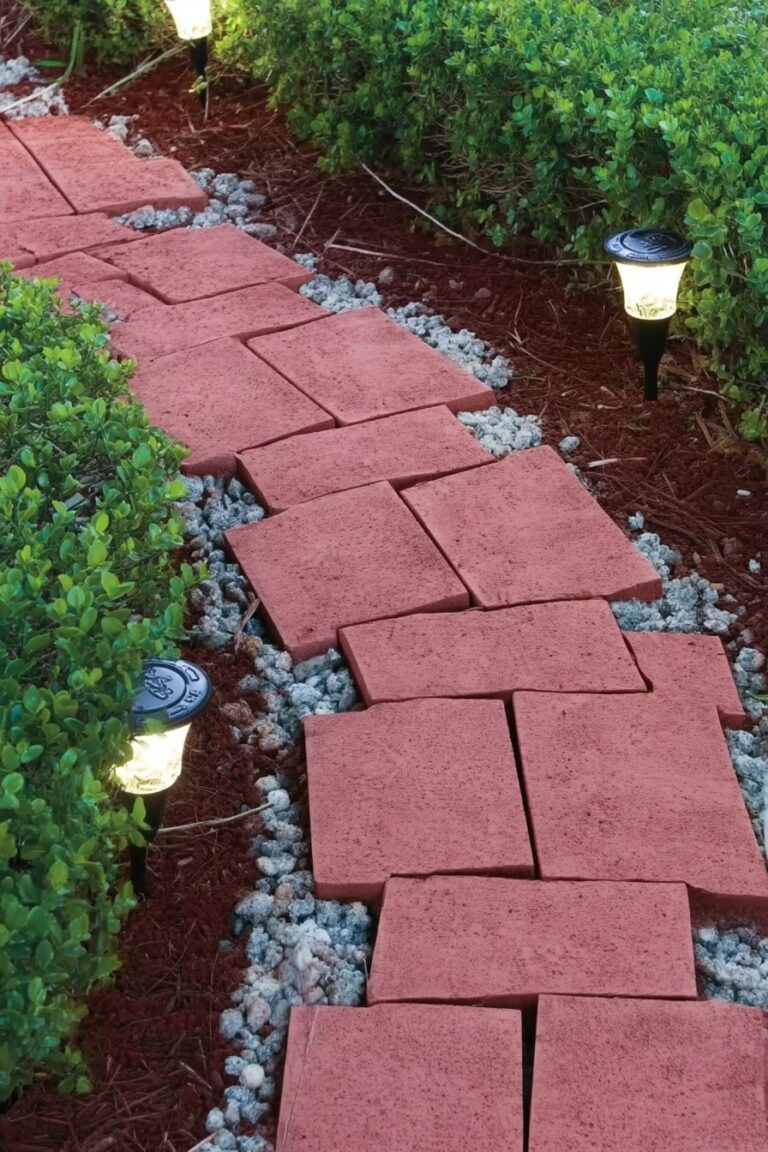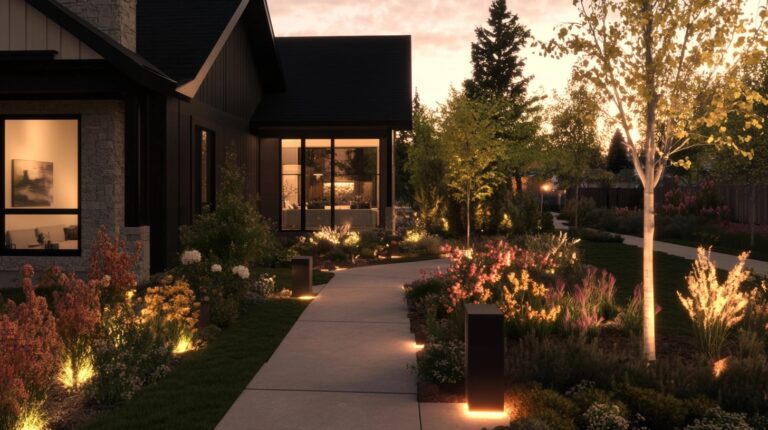Whether you’re tired of soggy shortcuts across the lawn or just want to add some serious charm, stone walkways are such a fantastic solution. From elegant flagstone pathways to rustic rock trails, let’s explore some gorgeous ideas together. Get ready to be inspired to lay down a path you’ll love walking on!
20 Classy Stone Walkways Paths and Rock Pathway Ideas for Instant Garden Drama
1. Simple Square Pavers in Grass
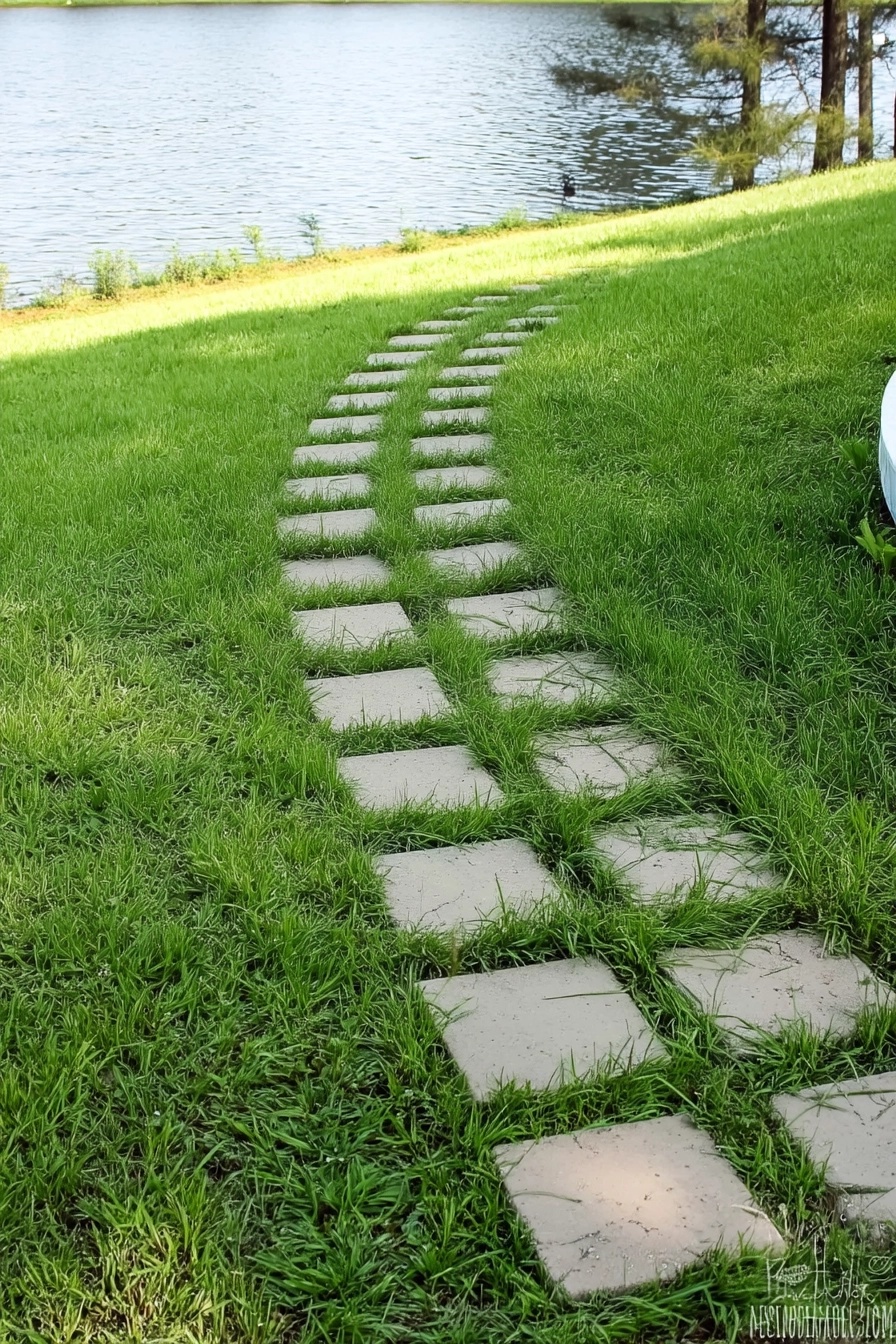
Okay, let’s start with something classic and relatively easy. Setting square pavers right into your lawn is a super popular look. It gives you a solid place to walk without totally interrupting the green vibe of your yard.
I tried this once leading down to a little pond area. The trick is getting them level! Use a level tool on each paver and dig out just enough sod and soil so they sit flush or *slightly* above the ground. If they sink too low, they become hidden puddles after rain.
Mowing can be a bit tricky. You’ll likely need to use a string trimmer around the edges. But it’s a clean look that works almost anywhere, especially if you like that checkerboard feel leading to a focal point like the water here.
2. Paver Walkway with Rock Edging
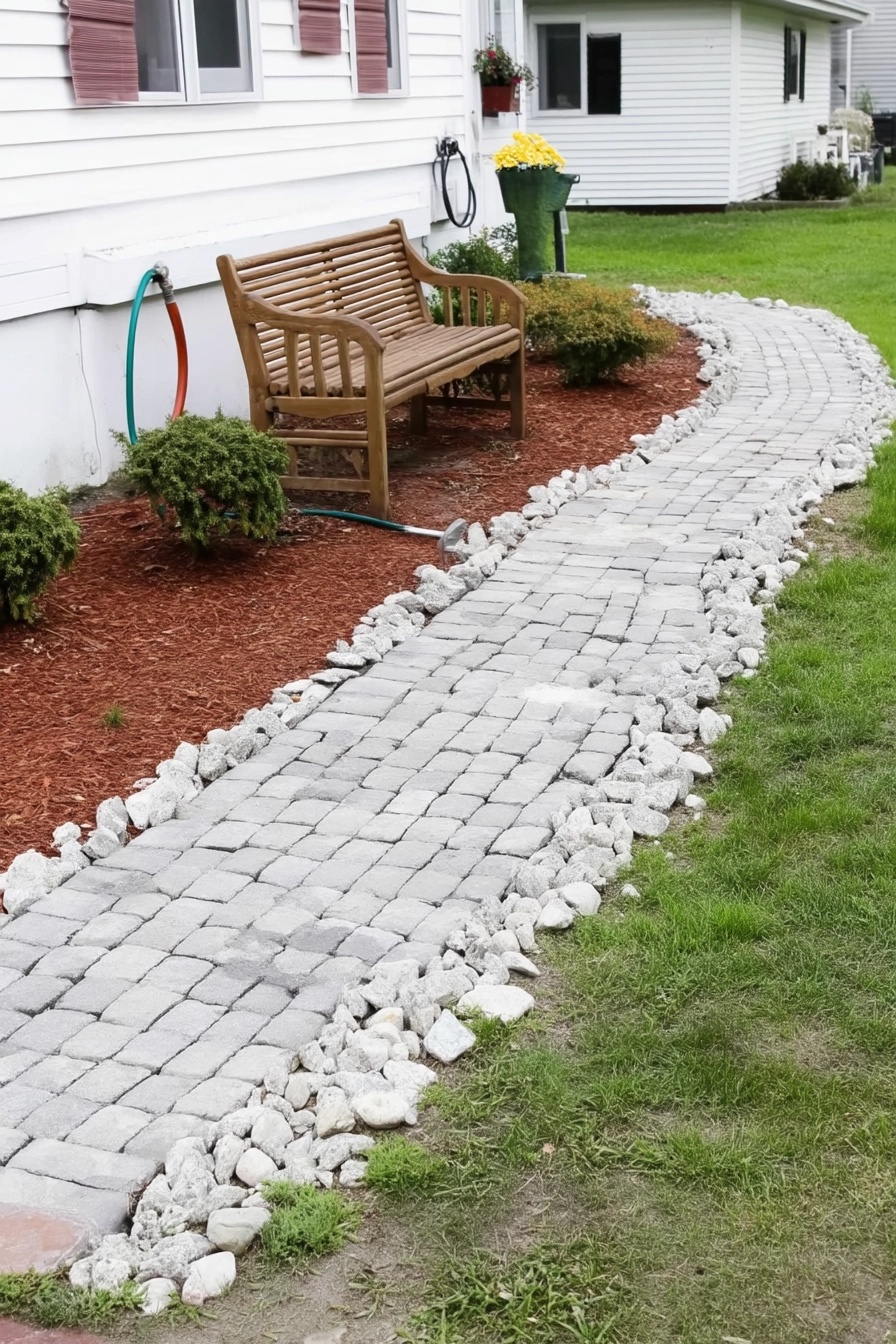
This look combines the neatness of interlocking pavers with a more rustic rock edge. It’s a great way to define the pathway clearly and keep mulch (like the red stuff here) from spilling onto your walkway.
The pavers provide a very stable, even surface, which is great for accessibility. Installing them takes some prep work – you need a good base of gravel and sand. Getting that curve right also requires careful planning, maybe even marking it out with landscape paint first.
Those white rocks for edging? They look sharp at first, but be warned: they can get dirty easily and might need occasional rinsing. Also, little rocks love to escape onto the path or into the grass, so some upkeep is needed.
3. Modern Large Pavers Set in Lawn
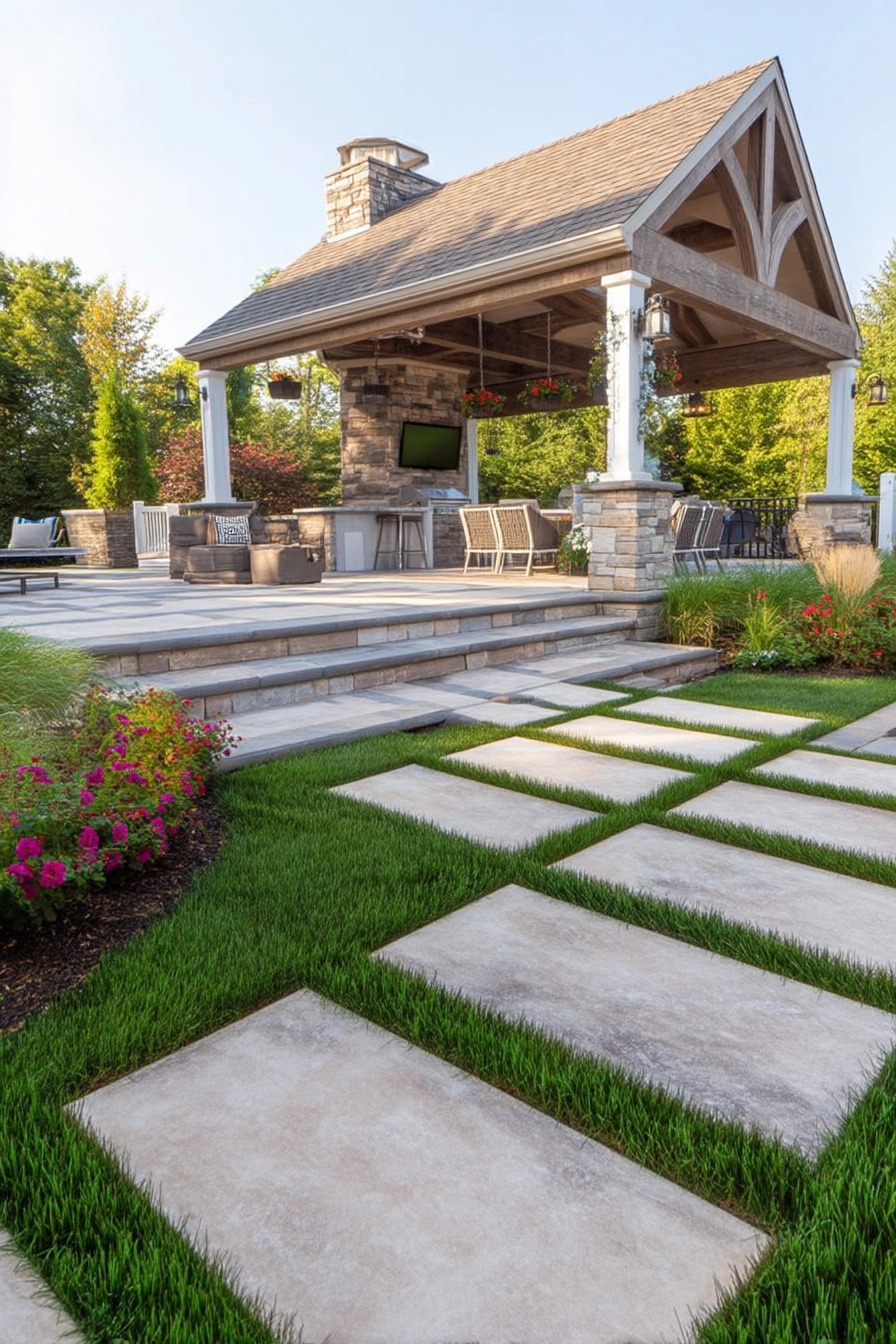
Now *this* is a statement! Using large rectangular pavers creates a very modern, upscale feel. Setting them right into the lawn like this offers a nice contrast between the hard stone and the soft grass.
Look how the grass grows neatly between the slabs – that takes precision! You need to cut the sod out *exactly* to size. My advice? Lay the paver down, trace around it with a sharp spade or knife, then remove the sod and a bit of soil.
These big guys are heavy, so moving them into place is often a two-person job. Make sure the ground underneath is compacted and level, otherwise, you’ll get annoying wobbles. It’s a high-impact look, perfect for leading to a stylish patio area like this one.
4. Winding Red Paver Path
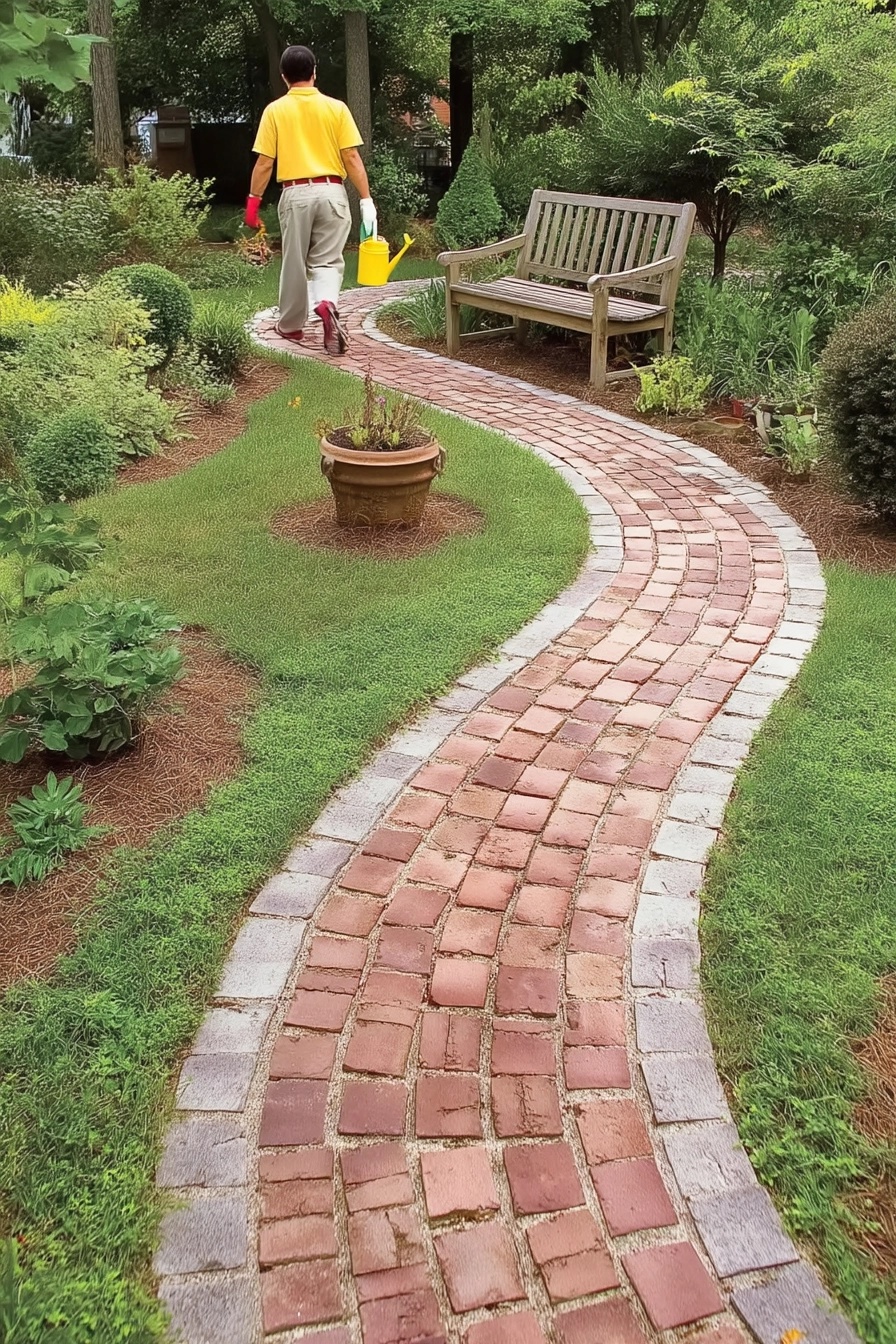
There’s something so charming about a winding path, isn’t there? This one uses reddish pavers, which gives it a warm, inviting feel, almost like brick but likely more uniform.
The contrasting grey paver border really defines the shape and adds a touch of formality. Creating smooth curves like this with square or rectangular pavers requires some skill, often involving cutting pavers to fit the bends.
A tip I learned the hard way: when laying a curved path, start setting the pavers on the *inside* of the curve first. It helps maintain a smoother line. This style is perfect for cottage gardens or leading through planting beds.
5. Concrete Slabs Framed with Wood
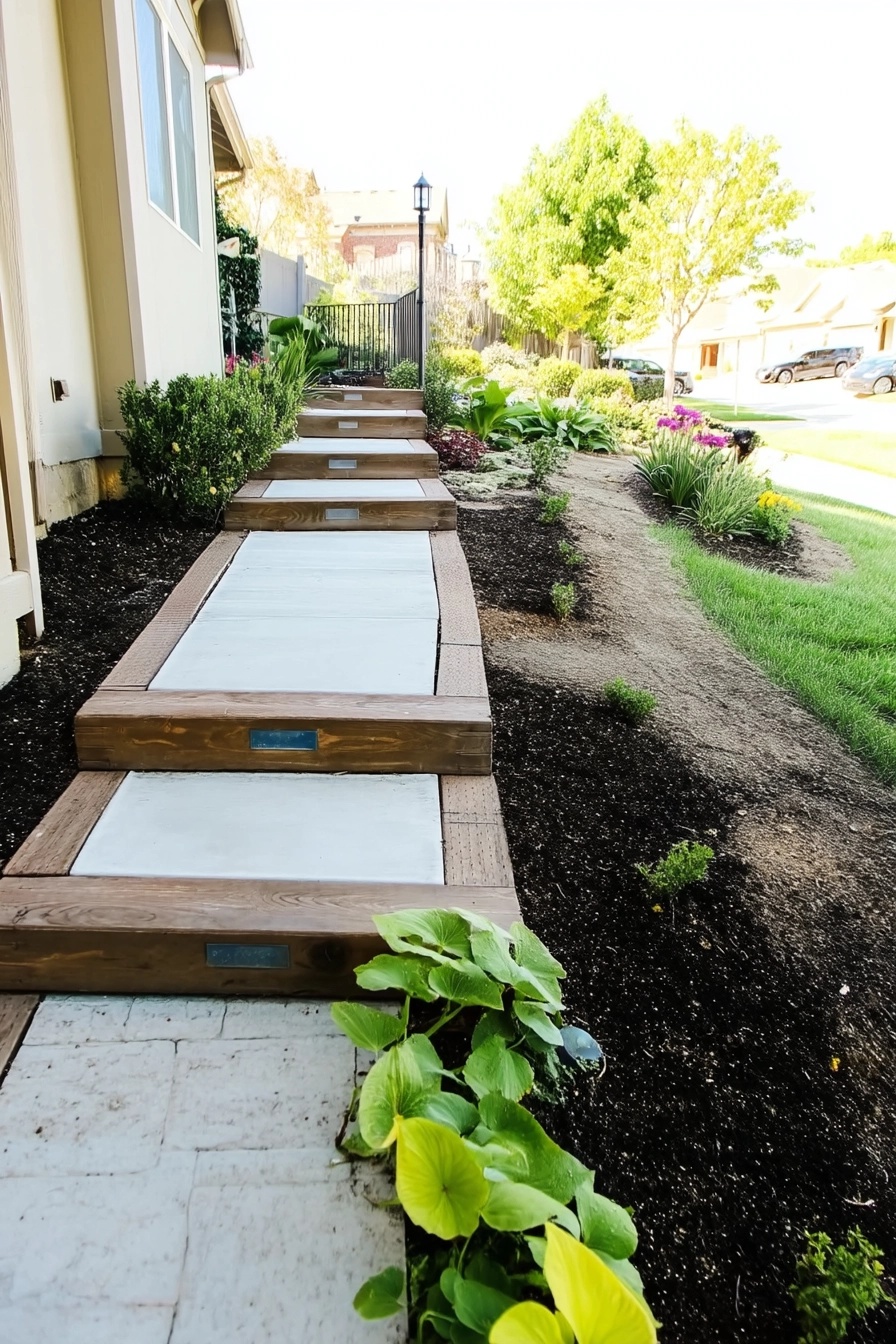
Here’s a cool, contemporary idea mixing materials. Simple concrete slabs are elevated (literally!) by being framed with chunky wood beams, creating defined steps or sections.
This works especially well on a gentle slope, turning it into an intentional feature. Make sure the wood used is treated for ground contact (like pressure-treated timber) or is naturally rot-resistant like cedar or redwood, otherwise it won’t last long.
Keeping the concrete clean and the wood maintained (maybe needing sealant every few years) is key. The contrast between the smooth grey concrete and the warm wood grain is really effective, giving a structured yet natural look.
6. Whimsical DIY Shell Stepping Stones
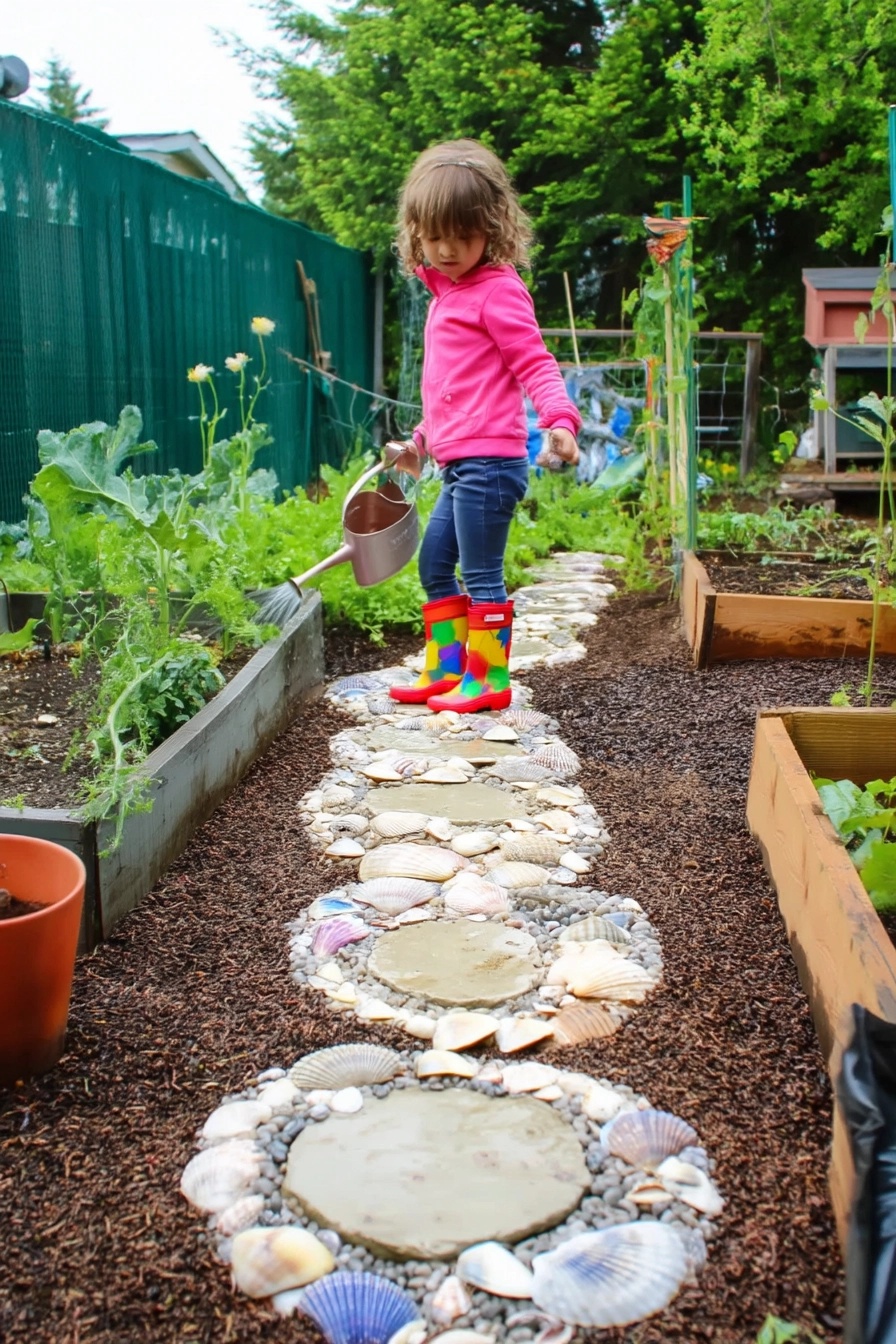
How fun is this?! This is a perfect example of a DIY rock pathway idea that adds tons of personality. These look like homemade stepping stones decorated with seashells.
You can buy kits to make stepping stones or just use quick-setting concrete in round molds (even old cake pans!). While the concrete is wet, you press in treasures like shells, sea glass, or colorful pebbles. It’s a fantastic project to do with kids.
Set these into a bed of mulch or gravel. They aren’t designed for heavy, constant traffic, more for adding a whimsical touch to a garden bed or a less-travelled area. They bring a smile, and that’s what gardening is often about!
7. Natural Irregular Flagstone Pathway
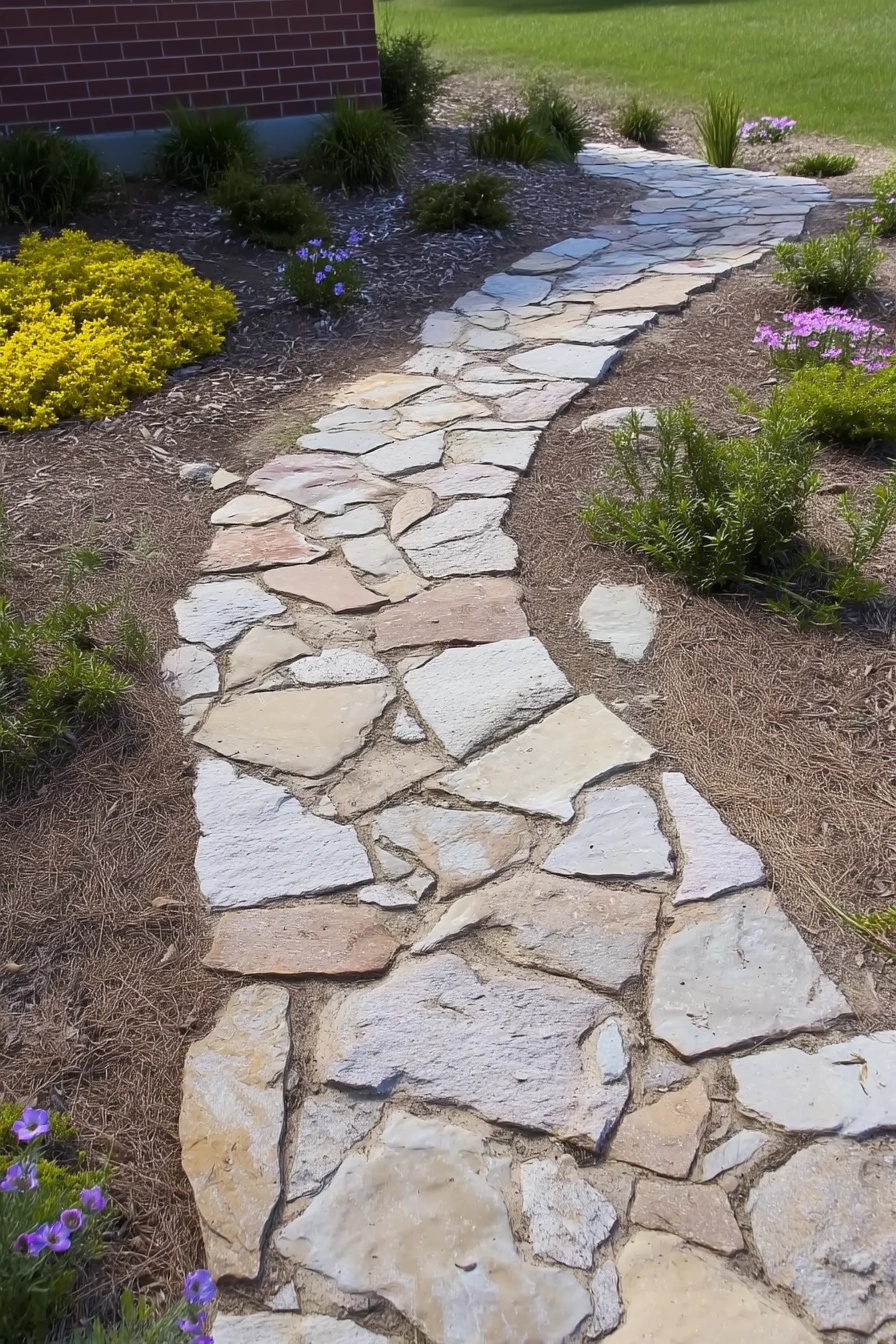
Ah, flagstone pathways! This is the quintessential natural look. Using irregular shapes and sizes gives an organic feel, like the path has always been there.
Laying flagstone like this, often called the “puzzle piece” method, takes patience. You have to find pieces that fit reasonably well together, leaving gaps that can be filled with mulch (like this pine straw), gravel, or even groundcover plants.
One challenge: keeping the filler material *in* the gaps and off the stones. Also, uneven flagstone can be a tripping hazard if not set properly. Aim to get the tops relatively level, even if the shapes are wild. It’s a beautiful, timeless choice.
8. Classic Red Brick Meets Stacked Stone
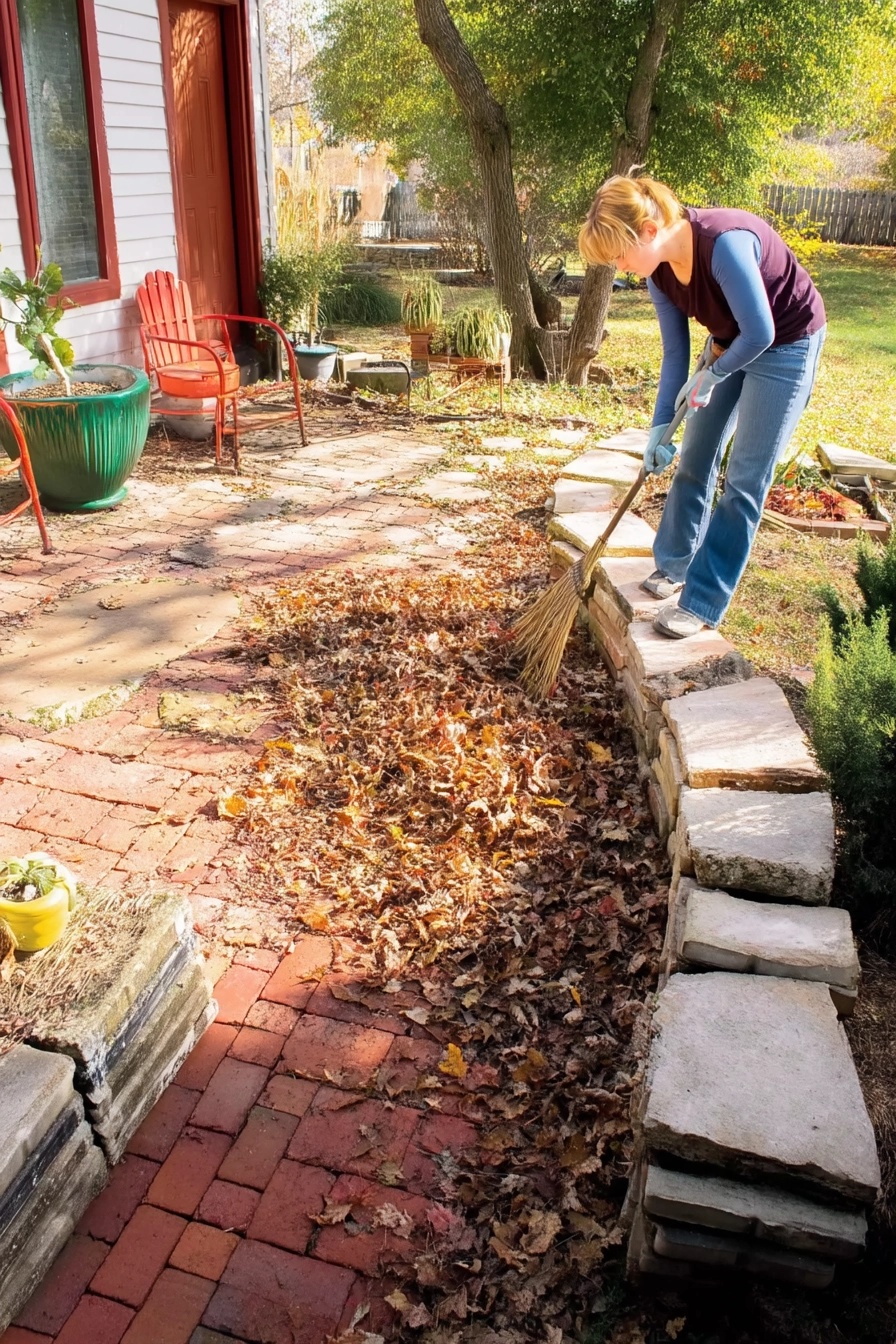
This image shows a classic red brick path running alongside a low wall made of stacked, chunky stones. It’s a sturdy, traditional look that feels very established.
Brick paths need a good base and often sand swept between the joints to lock them in place. They can sometimes get mossy or uneven over time, which adds to the charm for some folks, but requires maintenance if you prefer perfection.
The stacked stone wall acts as garden edging or even a small retaining wall. Building a stable dry-stacked wall (without mortar) takes practice – you need to overlap the joints and choose stones that fit snugly. It’s a great combo for adding texture and structure.
9. Artistic Pebble Mosaic Walkway
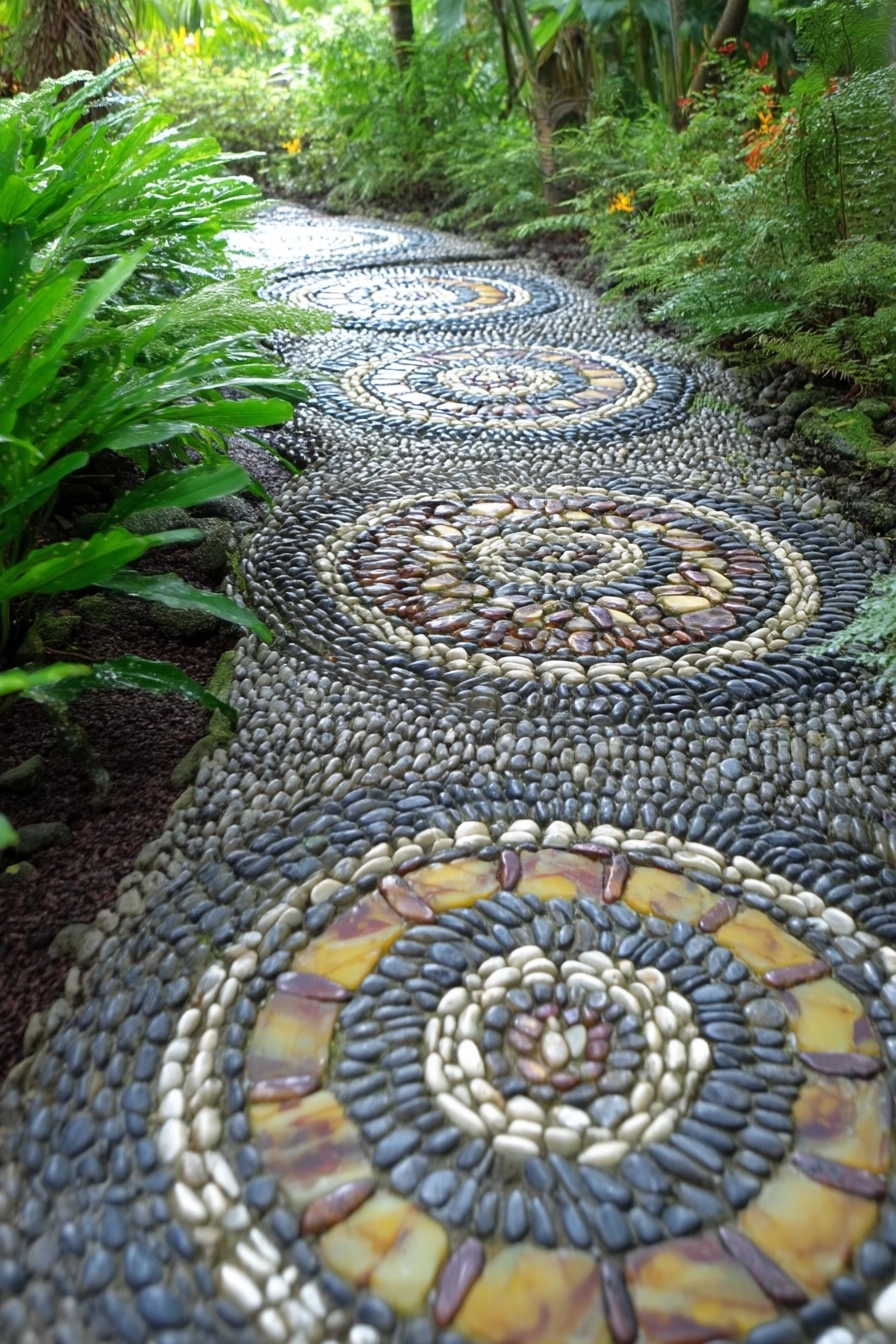
Wow! This isn’t just a path; it’s a work of art. Creating pebble mosaics is an ancient technique that takes serious dedication and an artistic eye. Smooth river stones are often set on edge in mortar or sand.
This is definitely not a weekend project! Planning the pattern, sourcing the right size and color pebbles, and carefully setting each one is time-consuming. But the result? Absolutely stunning and unique stone pathways ideas walkways.
Walking on these might feel a bit bumpy compared to smooth pavers, so it’s maybe best for areas where you stroll slowly and appreciate the beauty. It’s a true garden showstopper.
10. Illuminated Paver Path for Nighttime
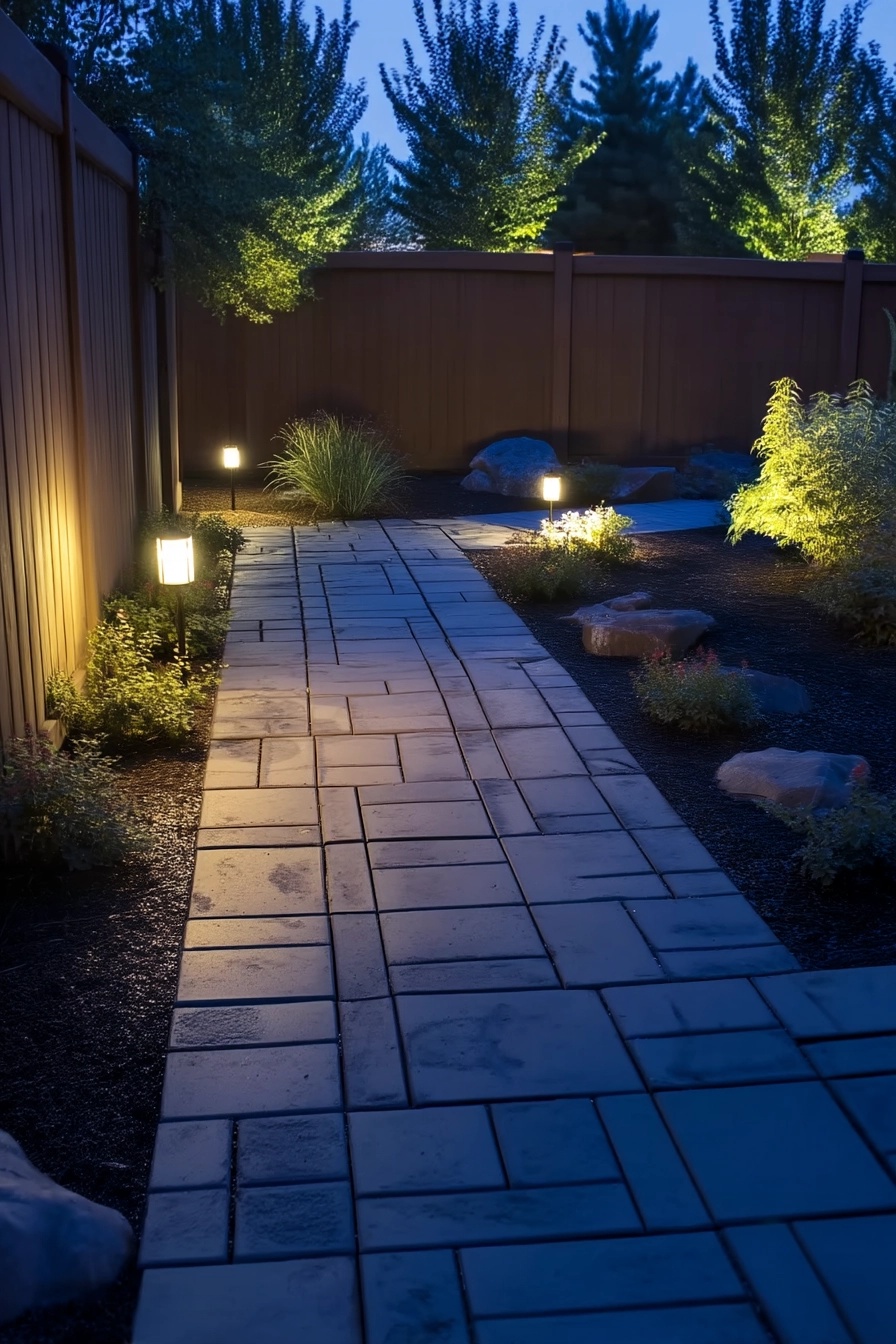
Don’t forget about nighttime! This paver path looks great during the day, but adding landscape lighting transforms it after dark. Low-voltage lights along the edge provide safety and ambiance.
There are tons of lighting options: solar lights (easy install, but sometimes dim) or low-voltage systems (brighter, more reliable, but require burying wires and a transformer). Planning the wiring *before* you finalize the path base is smart!
Good lighting highlights the path’s texture and shape, guides guests safely, and adds serious curb appeal. It makes your garden usable and beautiful 24/7.
11. Textured Pavers for Patio Adjacent Paths
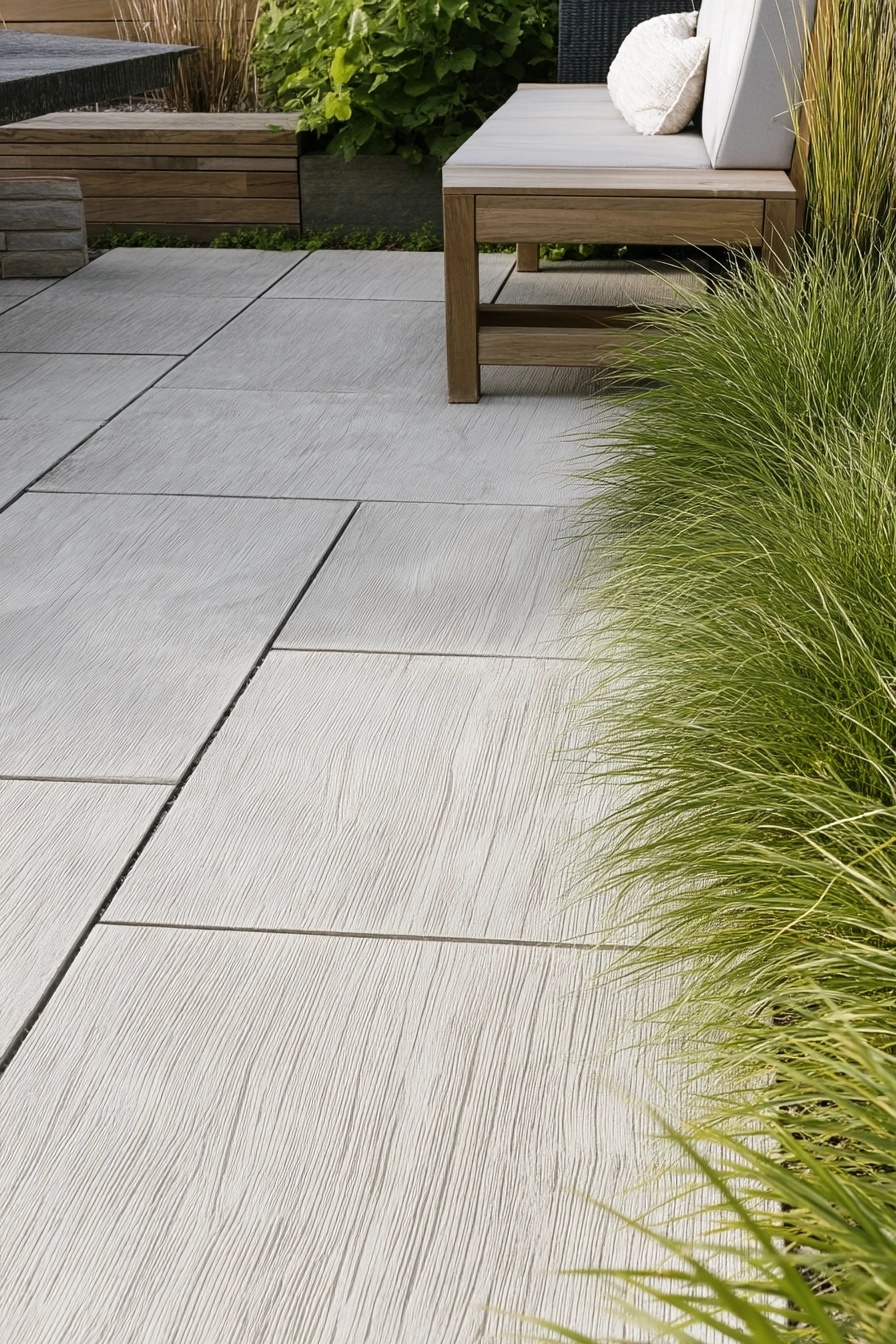
Sometimes the path is part of a larger paved area, like a patio. These large, rectangular pavers have a subtle texture, almost like wood grain. It adds visual interest without being too busy.
Choosing pavers with a bit of texture can also improve slip resistance, which is important for walking surfaces, especially near seating areas where spills might happen.
The clean lines and tight fit give a very sleek, modern look. Pairing them with soft ornamental grasses, like shown here, creates a lovely contrast in textures.
12. Floating Concrete Slabs Over Gravel
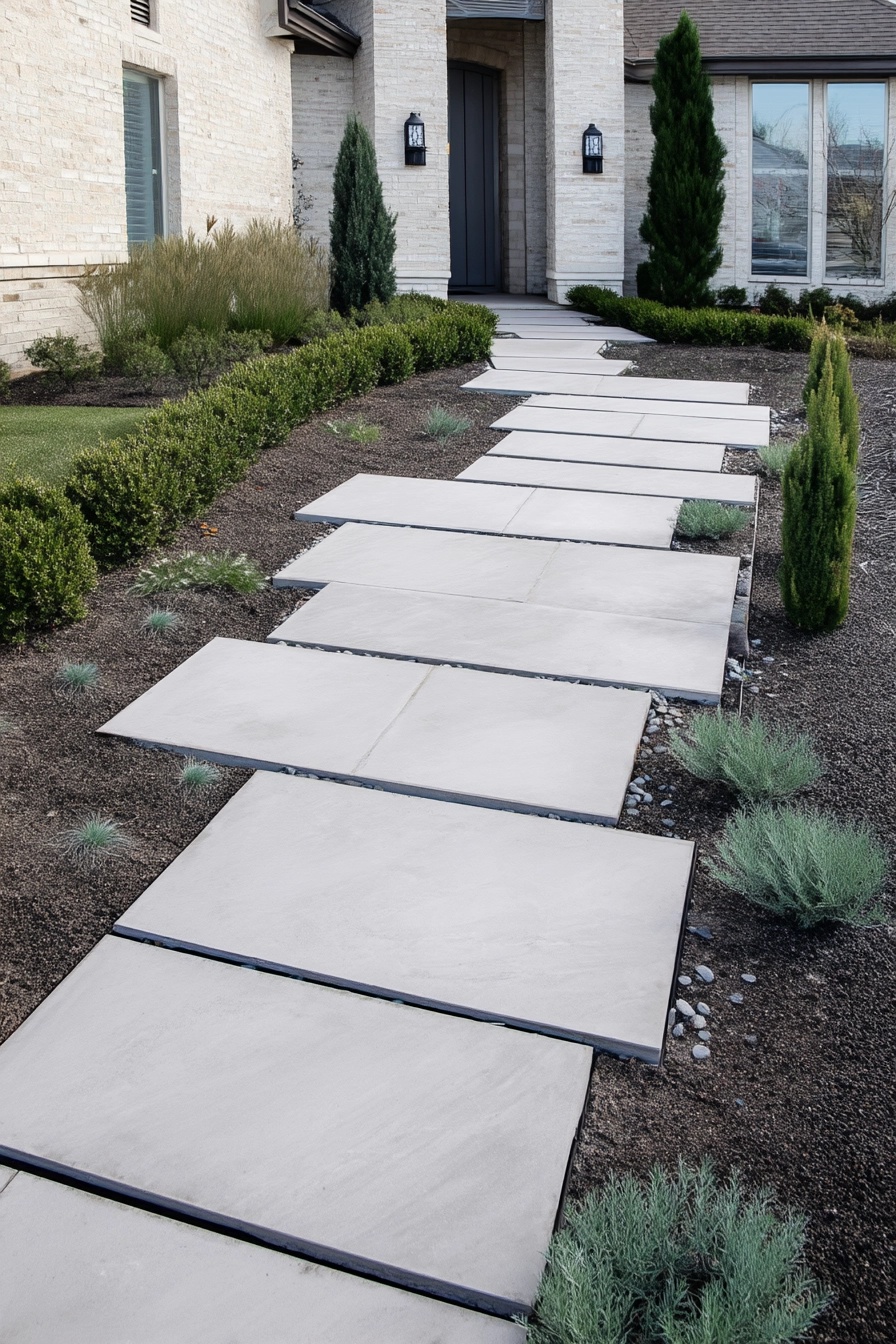
Here’s another take on the large paver look. These slabs are set over a bed of dark gravel, creating a “floating” effect. It’s very minimalist and chic.
The key is a thick, well-compacted gravel base. The pavers sit on top, spaced apart. This style allows for excellent drainage as rainwater just disappears into the gravel bed.
Pros: Looks super modern, great drainage.
Cons: Weeds can pop up in the gravel (landscape fabric underneath helps!), and keeping the gravel tidy requires occasional raking. Heel-wearers might not love walking directly on the gravel between the slabs.
13. DIY Paver Path Under Construction
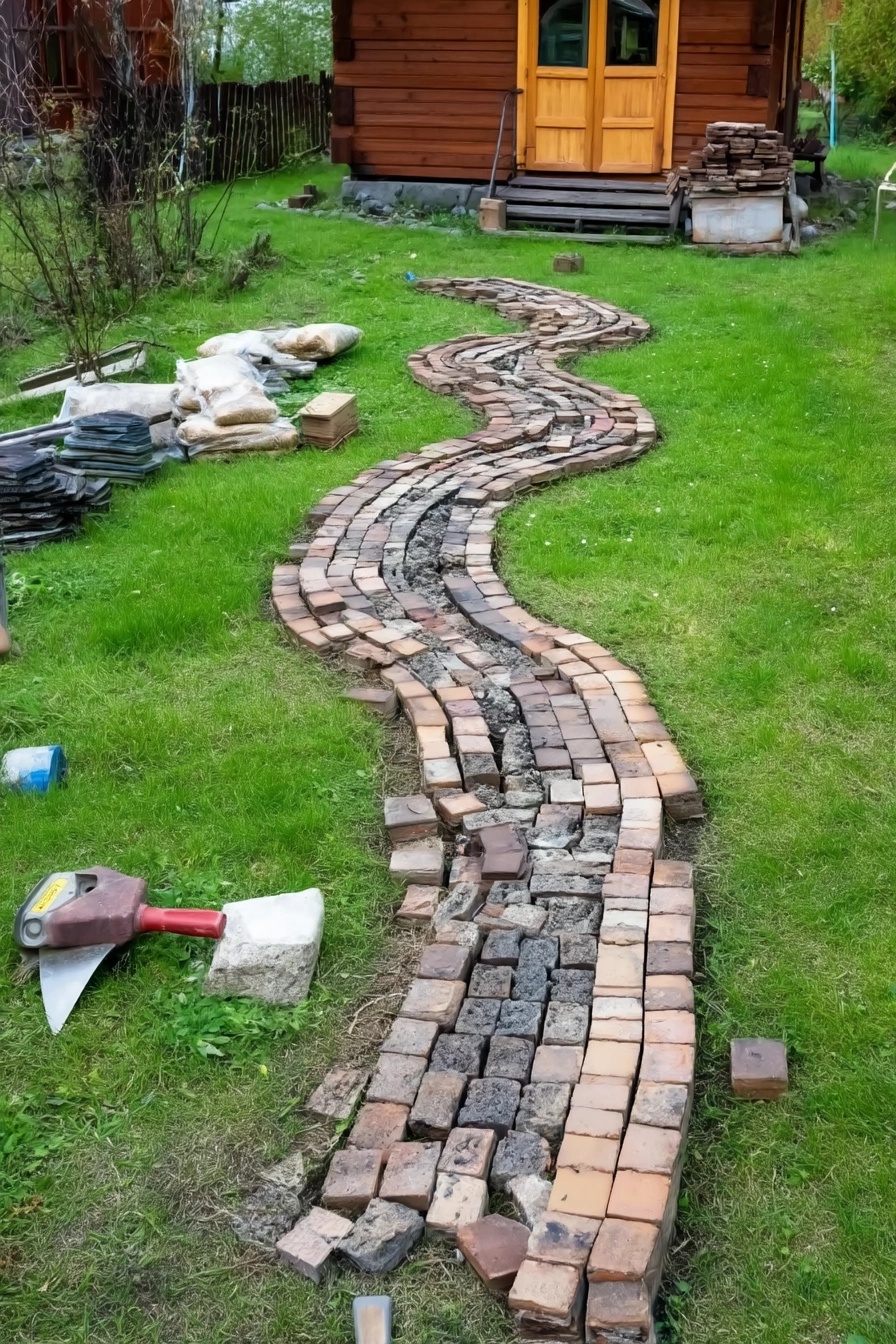
I love seeing projects in progress! This shows a DIY paver path being laid. You can see the curve taking shape and the slight messiness that comes with landscaping projects (totally normal!).
Looks like they might be using reclaimed or tumbled pavers for a more rustic look. Laying pavers, especially curves, involves digging out the path shape, adding a base layer (usually compacted gravel), a leveling layer of sand, setting the pavers, and then filling the joints.
Tools you’d typically need: shovel, tamper (manual or rented), level, rubber mallet, maybe a wet saw for cuts. It’s hard work, especially the digging and base prep, but so rewarding when you walk on your finished path!
14. Sleek Pavers Set in Pea Gravel
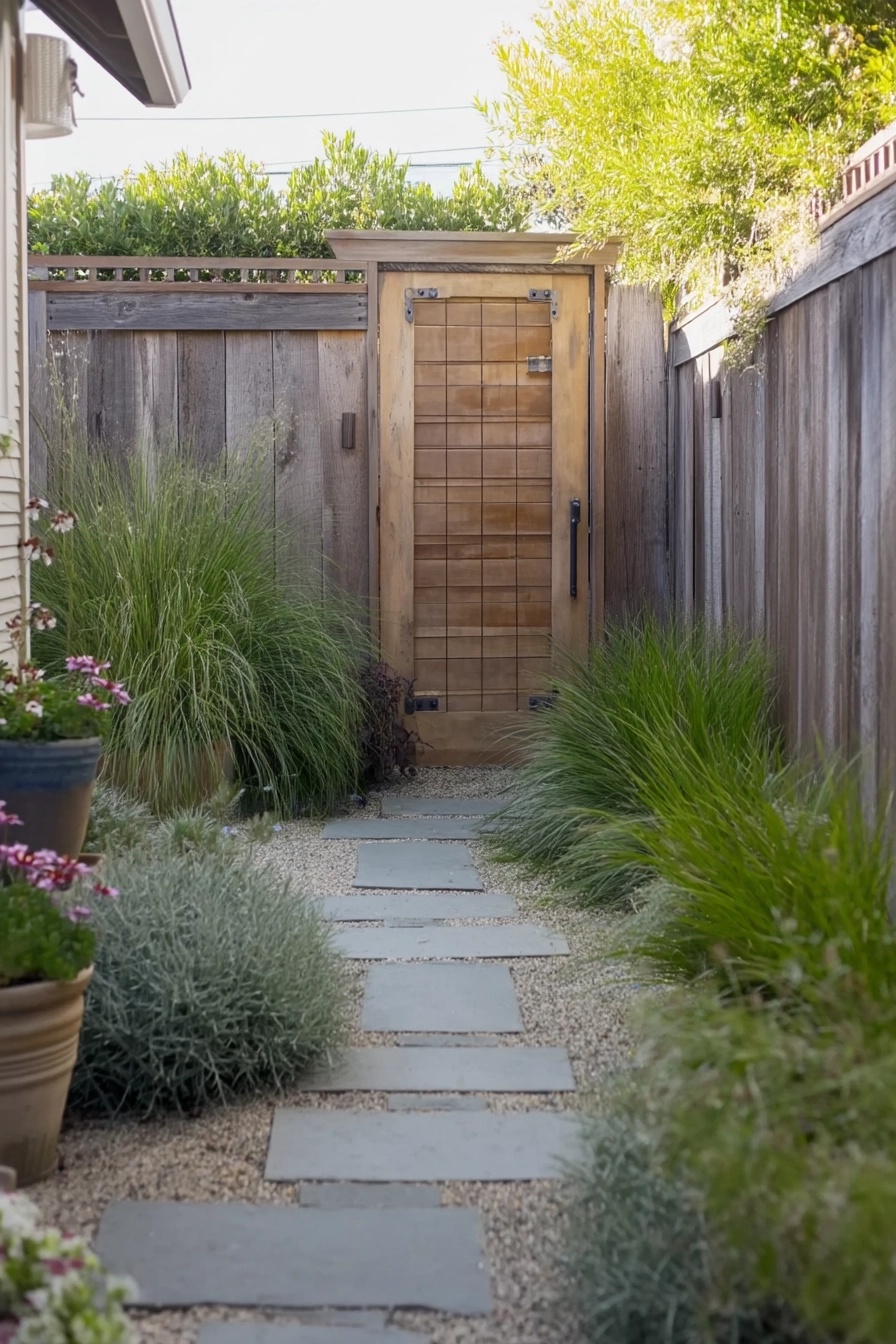
This is a really neat and tidy look. Rectangular pavers provide the solid walking surface, while the surrounding pea gravel adds texture and fills the space beautifully.
Pea gravel is popular because it’s smooth and has a nice sound underfoot. However, it can shift around easily! Using landscape edging (even hidden plastic edging) is almost essential to keep the gravel contained and prevent it from migrating into garden beds or lawns.
This combo works well in smaller spaces, like side yards leading to a gate. The clean lines of the pavers contrast nicely with the soft plantings alongside.
15. Flagstone Path Through Lush Ferns
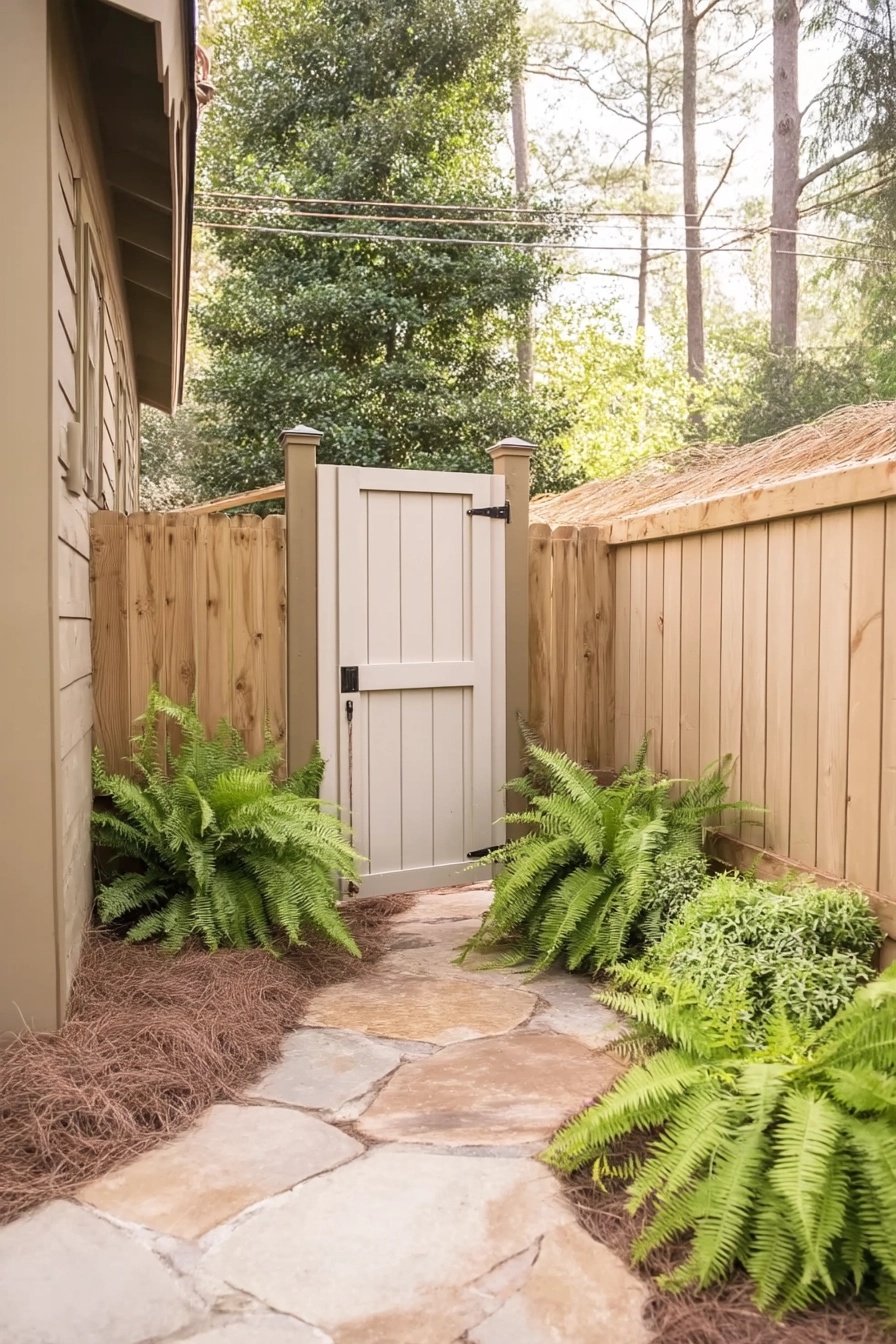
Doesn’t this just feel like a secret garden path? Irregular flagstone pieces create a rustic pathway winding through shade-loving ferns. The pine straw mulch adds to the woodland feel.
This is a perfect example of letting the path blend into the environment. Flagstone paths work incredibly well in shady areas where grass struggles to grow. The ferns soften the edges of the stone beautifully.
When placing flagstones like this, think about the natural stride length. You don’t want the stones too far apart or too close together. It should feel comfortable and intuitive to walk on.
16. Fun Stenciled Concrete Pavers
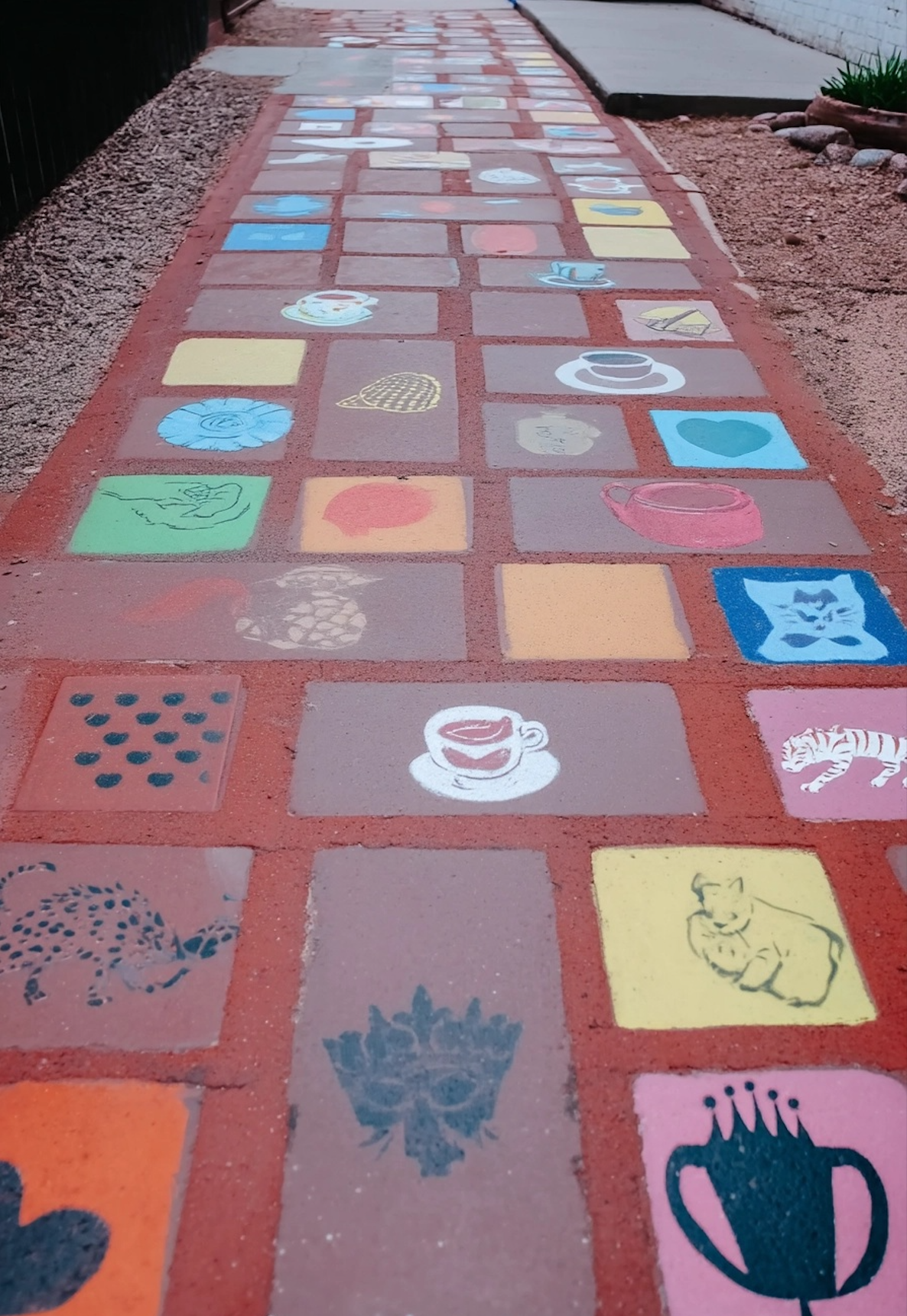
Got plain, boring concrete pavers? Give them a personality makeover with stencils! This is a fantastic way to add color and fun to an existing path without replacing it.
You can buy pre-made stencils or make your own. Use outdoor or porch paint designed for concrete for durability. Make sure the pavers are super clean before you start painting.
This is such a creative idea, especially for a kids’ play area or just to add a splash of unexpected joy to your garden walk. It shows that stone pathways ideas walkways don’t have to be serious!
17. Round Flagstones with Pebble Infill
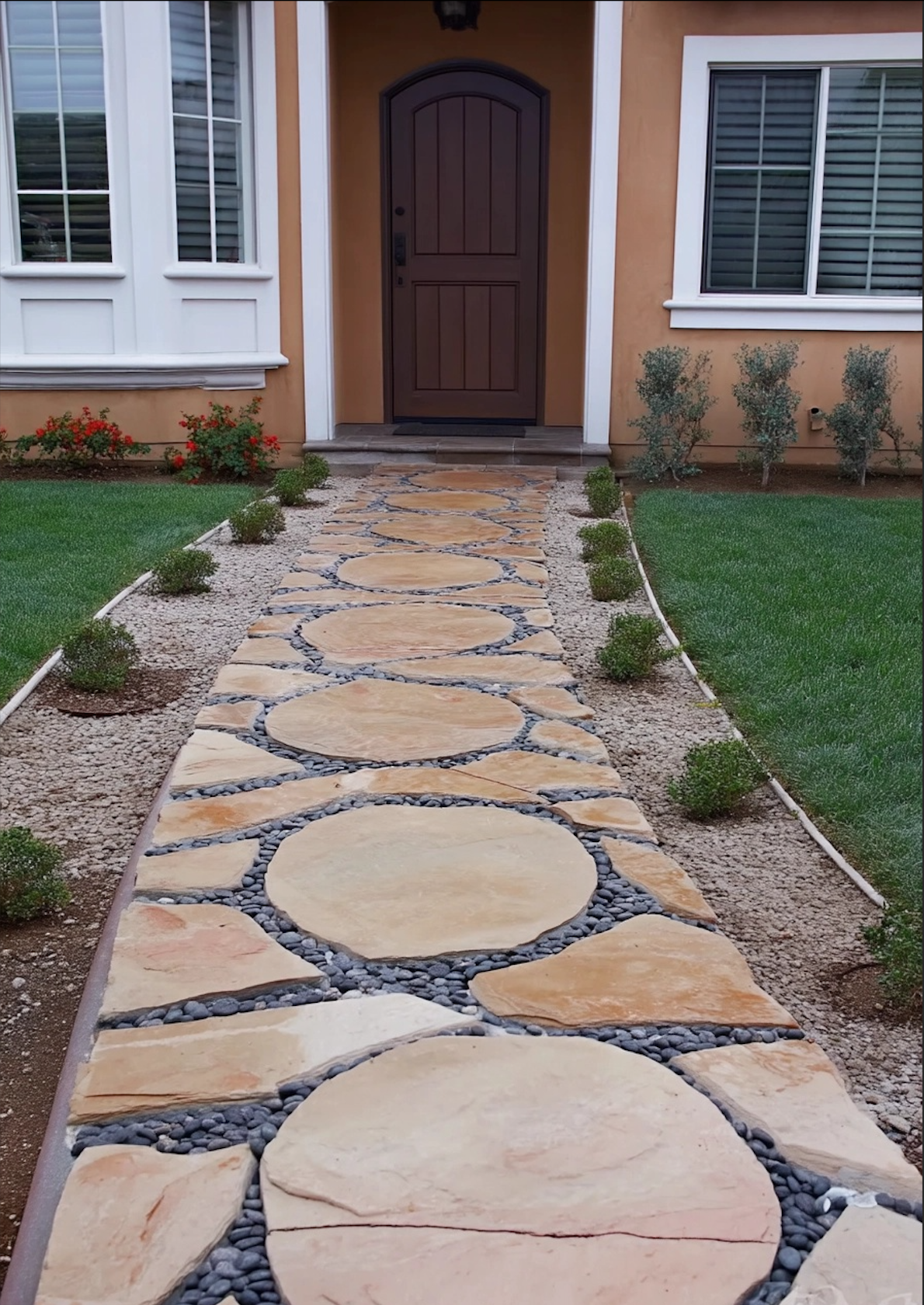
This is a really interesting combination! Large, roughly circular flagstones serve as the main stepping surfaces, while smaller, darker pebbles fill the gaps in between.
It creates a bold, graphic pattern. You need fairly large, flat-topped roundish stones for this to work well as a comfortable walkway. The contrast between the smooth, large stones and the small, textured pebbles is key to the look.
Keeping the pebbles contained within the path area is important. Metal or plastic landscape edging, possibly hidden just below the surface, would help maintain those clean lines, especially where the path meets the lawn or garden beds.
18. Flagstone Path with Decorative Pebble Inlay

Take a look at the detail here! This flagstone pathway uses a technique where narrow channels are intentionally left between the larger stones and filled precisely with smaller, contrasting pebbles.
It’s like grout lines, but made of pebbles! This requires careful placement of the flagstones and a neat hand when adding the pebble infill. It elevates a standard flagstone path into something more refined and custom-looking.
This style works beautifully leading up to a formal entrance. It shows attention to detail and adds a layer of texture and sophistication to the walkway.
19. Gravel Pathway Transformation (Before & After)
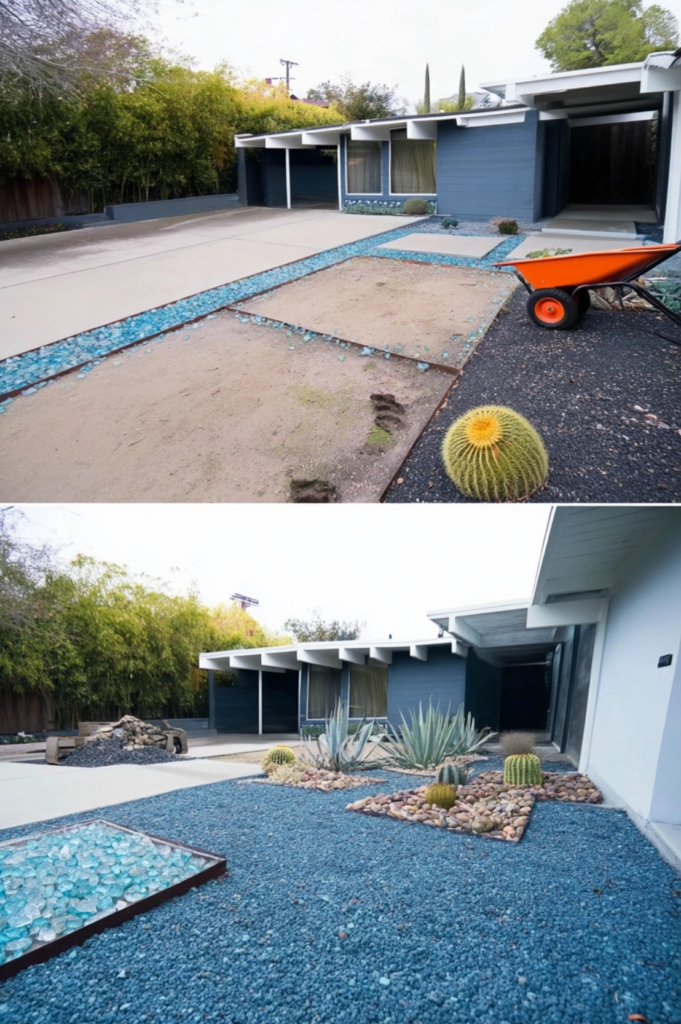
Okay, check out this transformation! The ‘before’ looks like a bare, maybe problematic area, and the ‘after’ is a super stylish, modern xeriscape (low-water) garden path using gravel.
They’ve used different types and colors of gravel to define areas – a main pathway, planting beds with cacti, and even some bright blue accent gravel! This is a fantastic solution for dry climates or low-maintenance gardens.
Proper ground preparation is crucial for gravel paths: remove weeds, compact the soil, and lay down good quality landscape fabric underneath to suppress weeds. The ‘after’ looks so much more intentional and adds huge curb appeal.
20. Floating Steppers in River Rock
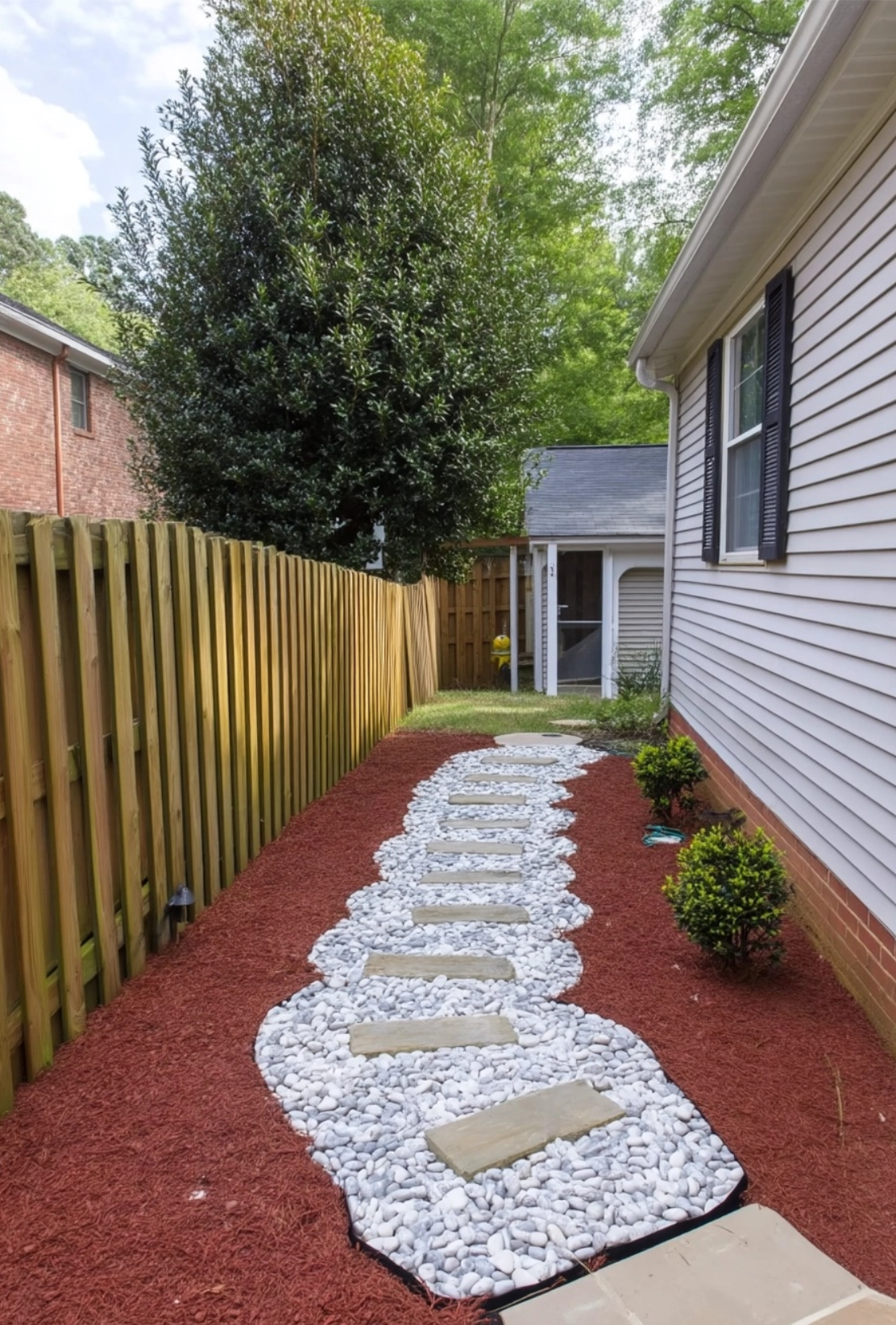
Here’s a variation on the stepping stone theme. Rectangular stone slabs are set like islands within a sea of smooth, white river rocks. The whole path curves gently through red mulch.
The contrast between the smooth white rocks, the sharp-edged steppers, and the red mulch is really striking. River rocks tend to stay put better than smaller pea gravel, but they can still shift a bit.
This type of path adds a lot of texture and visual interest. It works well alongside houses or fences, defining a clear walkway while keeping things looking bright and clean (though white rocks do show dirt eventually!).
FAQ
What makes flagstone a popular choice for pathways?
Flagstone pathways are highly valued for their natural, irregular shapes and rich color variations, creating visually unique and appealing walkways. They provide a durable, stable surface that blends seamlessly into diverse garden designs, offering both beauty and function.
Are gravel walkways a good budget-friendly option?
Yes, gravel walkways are often considered one of the most affordable pathway materials, making them a great budget-friendly choice. They provide excellent drainage, are relatively easy to install, and offer a satisfying crunch underfoot for a more rustic feel.
What are some different rock pathway ideas besides flagstone or gravel?
Beyond classic flagstone or simple gravel, you can get creative with rock pathway ideas like using smooth river stones for texture, setting large stepping stones within mulch or grass for a modern look, or using decomposed granite for a firm, natural surface. Combining various rock sizes and types can also lead to unique and stunning designs.

